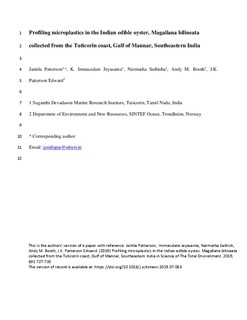| dc.contributor.author | Patterson, Jamila | |
| dc.contributor.author | Jeyasanta, K. Immaculate | |
| dc.contributor.author | Sathish, Narmatha | |
| dc.contributor.author | Booth, Andy | |
| dc.contributor.author | Patterson Edward, J.K. | |
| dc.date.accessioned | 2020-03-17T08:35:52Z | |
| dc.date.available | 2020-03-17T08:35:52Z | |
| dc.date.created | 2019-07-21T13:52:25Z | |
| dc.date.issued | 2019-11-15 | |
| dc.identifier.citation | Science of the Total Environment. 2019, 691 727-735. | nb_NO |
| dc.identifier.issn | 0048-9697 | |
| dc.identifier.uri | http://hdl.handle.net/11250/2647093 | |
| dc.description.abstract | The objective of this study is to quantify the extent of microplastic (MP) contamination in the Indian edible oyster (Magallana bilineata) and to understand how this relates to the MP contamination in its surrounding marine environment. Samples of water, sediment and oysters of different sizes were collected from three sites along Tuticorin coast in Gulf of Mannar in Southeast India. The mean abundance of MP in oysters was found to be 6.9 ± 3.84 items/individual and the mean concentration to be 0.81 ± 0.45 items/g of tissue. Polyethylene (PE) and polypropylene (PP) fibers were the dominant MP types in oysters (92% and 4%, respectively) and in seawater (75% and 25%, respectively), with PE fibers, ranging from 0.25 to 0.5 mm, being the most common. Both PE and PP are low-density polymers which are slow to sediment to the seafloor. This increases the potential of their availability in the environment and ingestion by the oysters. The largest oysters (14–16 cm) contained the highest abundance and concentrations of MP, suggesting a greater proportion of MP in the water column is ingested with increasing size. The calculated microplastic index (0.02 to 0.99) also indicates that MP bioavailability increases with increasing size of oysters. The distribution patterns of MP abundance, shape and size in oysters more closely resemble those in water than in sediment. The surface morphology of the MPs reveals the characteristic pits and cracks which result from partial degradation through the weathering processes. Energy-dispersive X-ray spectroscopy analysis shows the presence of Ni and Fe in association with MP, and this probably indicates the fly-ash pollution and the petroleum-related activities in the surrounding area. Being sessile animals the oysters are good candidates for use as sentinel organisms for monitoring MP in specific marine environments. | nb_NO |
| dc.language.iso | eng | nb_NO |
| dc.publisher | Elsevier | nb_NO |
| dc.relation.uri | https://www.sciencedirect.com/science/article/pii/S0048969719331766?dgcid=coauthor#! | |
| dc.rights | Attribution-NonCommercial-NoDerivatives 4.0 Internasjonal | * |
| dc.rights.uri | http://creativecommons.org/licenses/by-nc-nd/4.0/deed.no | * |
| dc.subject | Microplastic index | nb_NO |
| dc.subject | Water | nb_NO |
| dc.subject | Sediment | nb_NO |
| dc.subject | Organism size | nb_NO |
| dc.subject | SEM-EDAX | nb_NO |
| dc.title | Profiling microplastics in the Indian edible oyster, Magallana bilineata collected from the Tuticorin coast, Gulf of Mannar, Southeastern India | nb_NO |
| dc.type | Journal article | nb_NO |
| dc.type | Peer reviewed | nb_NO |
| dc.description.version | acceptedVersion | nb_NO |
| dc.source.pagenumber | 727-735 | nb_NO |
| dc.source.volume | 691 | nb_NO |
| dc.source.journal | Science of the Total Environment | nb_NO |
| dc.identifier.doi | 10.1016/j.scitotenv.2019.07.063 | |
| dc.identifier.cristin | 1712212 | |
| dc.relation.project | Norges forskningsråd: 257479 | nb_NO |
| cristin.unitcode | 7566,6,0,0 | |
| cristin.unitname | Miljø og nye ressurser | |
| cristin.ispublished | true | |
| cristin.fulltext | postprint | |
| cristin.qualitycode | 2 | |

